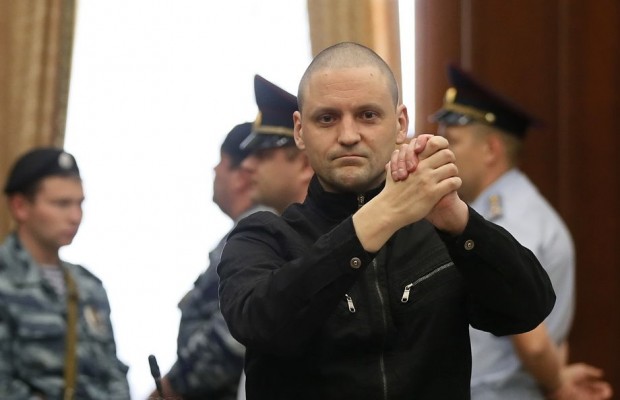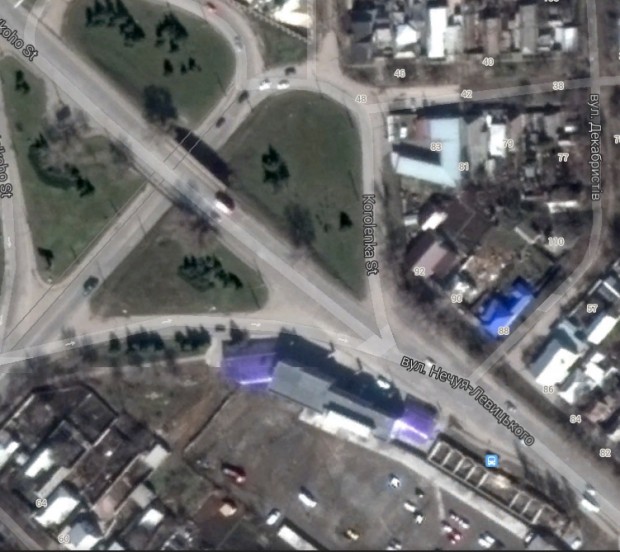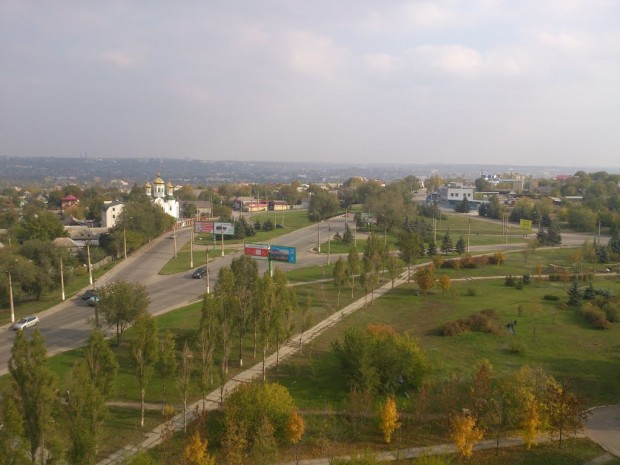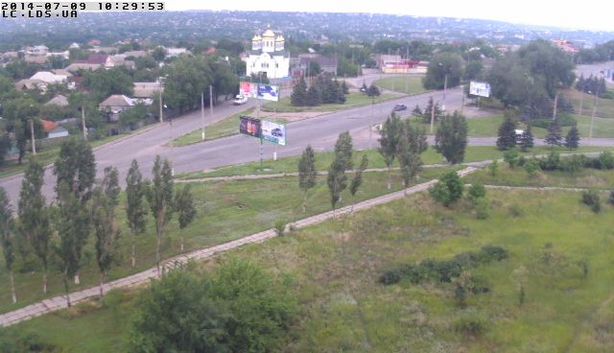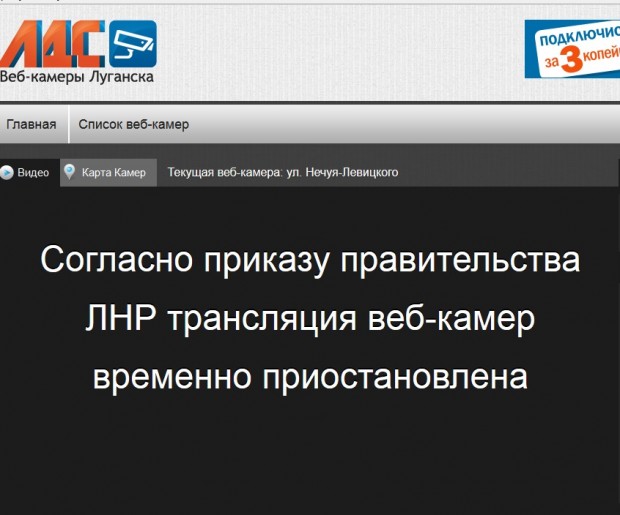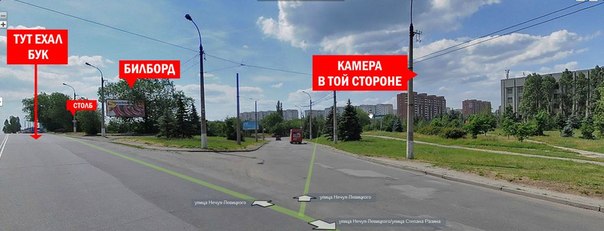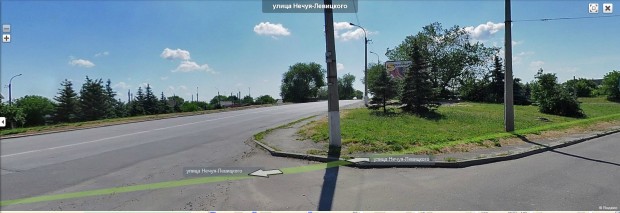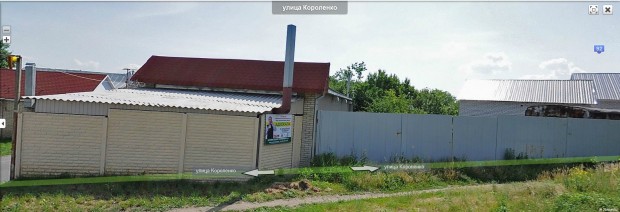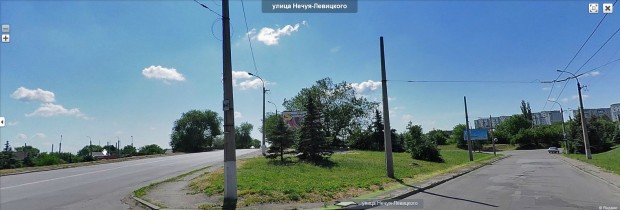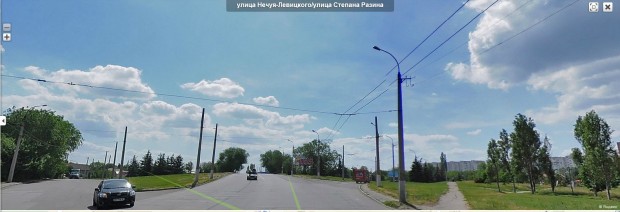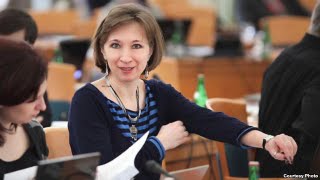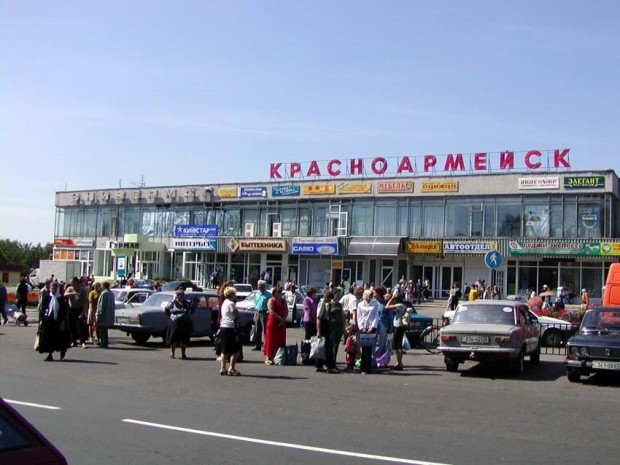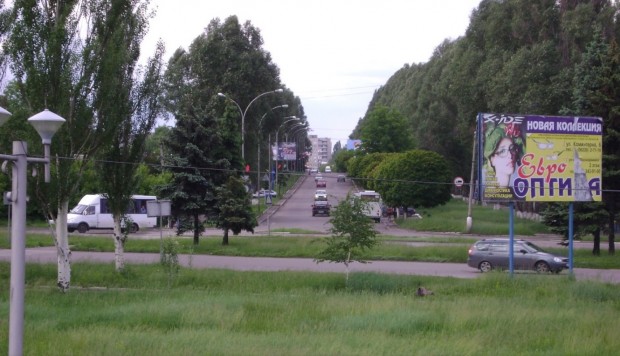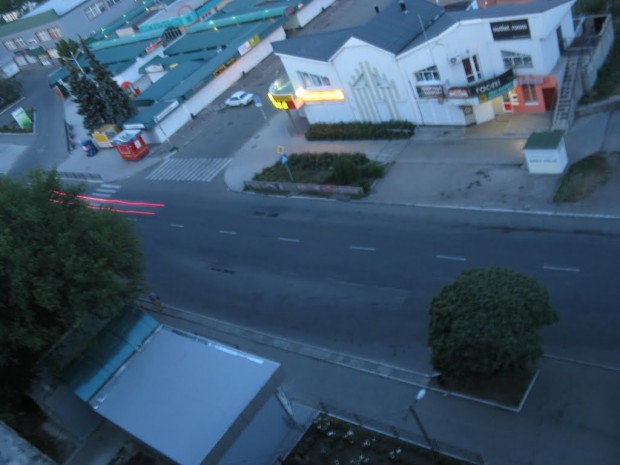Updated Daily. Opposition leaders Sergei Udaltsov and Leonid Razvozzhayev in the long-running Bolotnaya Case were found guilty by a Moscow court of “inciting mass riots” in protests against President Vladimir Putin on 6 May 2012 and sentenced to 4.5 years forced labor. Russian and Ukrainian bloggers confirmed the sighting of the Buk anti-aircraft missile system. The Russian Justice Ministry has entered five leading human rights groups into the registry of “foreign agents” against their will. The Russian Defense Ministry held a press briefing to present their claims about MH17, but their geolocation of a video showing a Buk by a billboard issued has been debunked as false.
For last week’s issue on ultranationalist Sergei Kurginyan’s boast that an electronics specialist was sent to repair a Buk anti-aircraft system for the separatists in Donetsk; the citizen reporter at the lake in Gukovo who filmed Grad rockets launching from Russian territory in Ukraine has had his VKontakte page removed; the fifth anniversary of the murder of Chechen human rights activist Natalya Estemirova; the worst accident in the Moscow metro’s history, with at least 21 dead and 160 injured; opposition candidates hear their private conversations aired on LifeNews, then find a bug in a campaign worker’s car; a new low for Russian state TV in its broadcasting of lurid war propaganda against Ukraine; and Facebook executive’s secret trip to Moscow leaving open the question of how social media companies will comply with a new regulation requiring all Russian customer data to be located on servers on Russian territory, go here.
For the previous week’s issue on the return of “Donetsk People’s Republic” (DPR) prime minister Aleksandr Boroday to Donetsk with claims of fresh military support to come from Russia; the retreat of Col. Igor Strelkov from Slavyansk and the regrouping of separatist forces in Donetsk has causing some of his supporters among Moscow’s ultranationalists to denounce him; on various hypotheses regarding the role of Kremlin “grey cardinal” Vyacheslav Surkov in brokering a peace deal with Ukrainian oligarchs eager to preserve their properties and investments from war, possibly involving a a “Donetsk Transdniestria”; and on the continued exaggeration by the Russian government of refugee numbers, with claims of “verification” by “the UNHCR,” even as journalists are denied access to border towns under a state of emergency; go here.
Please help The Interpreter to continue providing this valuable information service by making a donation towards our costs.
July 25, 2014
0037GMT: Two opposition leaders in the long-running Boltonaya Case were found guilty by a Moscow court of “inciting mass riots” in protests against President Vladir Putin on 6 May 2012, Moscow Times reported. Sergei Udaltsov and Leonid Razvozzhayev were sentenced to 4.5 years of forced labor colony each. Razvozzhayev was additionally sentenced to a fine of 160,000 rubles ($4,723), the supporters’ site 6may.org reported.
Udaltsov has been under house arrest since February 2013 and Rozvozzhayev was kidnapped in Kiev and forcibly returned to Russia for trial.
Remember Russians kidnapped Razvozhayev in Ukraine & now he goes to jail for years. Rule of law? http://t.co/YTNXsIbA3X via @MoscowTimes
— Michael McFaul (@McFaul) July 25, 2014
Depressing RT Court Rules Russian Opposition Leaders Guilty in Bolotnaya Mass Riots The Moscow Times http://t.co/YTNXsIbA3X via @MoscowTimes
— Michael McFaul (@McFaul) July 25, 2014
Novaya Gazeta ran a liveblog of the trial today by Olga Kryachkova. The Interpreter has translated an excerpt:
21:59 The court session is declared closed. The public shouts “Freedom!”
21:52 Sergei Udalsov is taken from the courtroom under guard.
21:51 The sentences of punishment are announced. Sergei Udaltsov – 4 years, 6 months of standard-regimen colony. Leonid Razvozzhayev – also 4 years and 6 months of standard-regimen coloney and fine of 150,000 rubles for unlawful crossing of the border.
21:49 Court comes to the conclusion of the proof of guilt of Udaltsov and Razvozzhayev in committing crimes.
21:43 The court declares all the actions of the defendants as committed deliberately.
21:42 “The actions of Udaltsov and Razvozahev in organizing mass disorders were carefully planned and coordinated.”
21:41 “The guiding chain consisting of unarmed police officers and Interior Ministry troops, guided the movement of the demonstrators and did not create obstacles. Despite the closed square and chain of enclosure, the demonstrators had the opportunity for free passage to the square.”
21:39 The court pronounces the testimonies of Udaltsov and Razvozzhayev as unfounded, which denied their participation in organization of mass disorders 6 May 2012, as well as their claims that the law-enforcement officers provoked participants into mass disorders to commit such actions.
21:36 Judge Zamashnyuk: “The court pronounces indisputably established that 6 May 2012, on Bolotnaya Square, the rally approved in advance grew into mass disorders. The court rejects the position of the defense stating that there was absence of evidence of a crime in the actios of Udaltsov and Razvozzhayev.
скорочтение pic.twitter.com/RY7WgULanh
— Катя (@sovkusomsahara) July 24, 2014
Translation: speed-reading.
The Interpreter has been covering the Bolotnaya Square trials for a year. Stories on sentencing of other defendants can be found here, here, and here, as well as and on the release and amnesty of several defendants.
July 23, 2014
0613GMT: On 21 July, we reported how Russian and Ukrainian bloggers and social media users began to crowd-search the location of a Buk anti-aircraft system in a video released by Ukrainian Interior Minister Arsen Avakov on 18 July. The Buk system, missing one of its four missiles, was the chief suspect in the allegation that pro-Russian separatists shot down the Malaysian airliner MH17.
Then pro-Kremlin bloggers descended en masse pushing a disinformation response to these efforts that distracted from establishing the location, which we debunked here. The Russian Defense Ministry then officially promoted this false geolocation in its briefing, adding to doubts and confusion.
In summing up everything we knew about the Buks, we pointed out that while some of the material regarding the position of Buks was confirmed, one photograph was questioned because it was discovered to have originated in a Facebook posting in March 2014 of the Ukrainian military’s Buks, not those in the hands of pro-Russian separatists, who are believed to have obtained them from Russia. A source in contact with the Ukrainian security authorities confirmed for us that this March picture was a mistake.
The Interpreter has provided a translation of Interior Minister Avakov’s original post 18 July, and other statements below:
“Today 18 July at 4:40 in the morning a trailer loaded with a caterpillar missile system was recorded by the Ukrainian Interior Ministry’s covert surveillance divisions, moving in the direction through Krasnodon, toward the Russian Federation border. In the videotape the exposed missiles are visible. Two of the missiles are in place; the middle one cannot be seen.
Analysis is underway of this and other collected information.
Preliminarily, this is precisely the Buk missile complex that yesterday produced the shot at the civilian plane from Amsterdam to Kuala-Lumpur.
The criminals are trying to hide the tracks of this monstrous crime. They will not succeed. The Ukrainian Security Service and Interior Ministry of Ukraine have collected already and are continuing to collect indisputable facts and evidences indicating the authors of this tragedy from the terrorist organization DPR/LPR and its Russian Putinist backers. At the completion of the investigation of the events, the Interior Ministry will publish a complete report of the information. I believe this fragment is necessary to publish immediately.”
The following video uploaded to Youtube by the SBU was then posted:
LiveJournal blogger egroegor came up with the Internet version of the same ad as on the billboard for the Bogdan auto dealer.
Then on Monday, 22 July, Avakov appeared again to issue to the press the coordinates of the video taken by the Interior Ministry agent. Over on our Ukrainian Liveblog, we reported how eventually after a group of people including our staff reviewed the material, the location was confirmed as the same as in the video.
Here’s the intersection of Korolenko St. and Nechuya-Levitsky Blvd. on Google Maps where the billboard stands:
As this collage summarizing multiple efforts put together by Ukraine@war doesn’t explain the sources of the elements in the scene, we’ll take you through the contributions of Russian and Ukrainian bloggers.
For #Russian trolls who still desperately try to discredit the #MH17 BUK video OUT of Ukraine http://t.co/G9H7fXSTcz pic.twitter.com/YFljPsSwBJ
— djp3tros (@djp3tros) July 22, 2014
Regional bloggers were the first to pick up and work with this material. Without their ground work no one in the West would be able to have ultimately confirmed the location.
Чуть подробнее по координатам съемки уезжающего российского Бука в Луганске.
48.545760°, 39.264622°
#MH17 pic.twitter.com/yush3ACYyU
— ЄВРОМАЙДАН (@euromaidan) July 22, 2014
Translation: A little bit more detail on the coordinates of the filming of the departing Russian [Federation] Buk in Lugansk.
But even with those coordinates to use on Google Maps, people remained skeptical because the scene on the film was done with a zoom lens and very close up, making elements of the picture smash together and then become difficult to tease a part on a map.
This picture from Panoramio contributed by user Dimc 12 October 2013 has a panoramic view of this junction in Lugansk, which was helpful in analyzing the scene.
Unnamed users also found this saved picture from a web cam trained on that intersection in Lugansk which also provides a panoramic view; interestingly, the web cam page now has a notice that “by orders of the government of the Lugansk People’s Republic, the web cam is temporarily suspended.)
All along we scoured billboard companies in the area to find the scene, although the company actually renting that corner’s billboards (or bigbordy as they are known locally) did not display the photo on their website.
LiveJournal blogger avva (Anatoly Vorobey) had one of the most useful threads on the hunt for the Buk.
This re-discovered 2 July story on Russian-backed separatists bringing a convoy of military vehicles and weapons through Lugansk at this very intersection was helpful — and drove home the point that the separatists take known routes in and out of Ukraine to Russia. The view in a photo published by informator.lg.ua also illustrates how some of the elements merge when viewed from an upper floor in a building, as the short video of the Buk was.
Then xeninghem, another LiveJournal blog taking part in avva’s thread brought together some useful points, with this annotated photo from Yandex Street View:
Translation (left to right): “Buk traveled here” “light pole” “billboard” “camera is from this side”
Yandex Street View, like Google Street View, then helps to illustrate where the rest of the elements line up — by going to Yandex Street View, you can immediately see that you are on an elevation, and that the camera view looks down on the next streets over, Stepan Razin St. and Korolenko St. So you can see as follows:
– the elevation on Nechaya-Levitsky Blvd.
– the red roof and white fence (which look like a red fence in the zoom view) and the grey roof of the building on Korolenko St, the next street over;
– the light pole with painted bottom and metal tag;
– and while you are looking around 360 degrees in Yandex Street View, be sure not to be run over by the trolleybus heading your way — here’s the view of its wires — yes, like Krasnodon, Lugansk has a trolleybus system, a detail critical to challenging the false geolocation by the Russian Defense Ministry.
As with Google Street View, it’s hard to get into the exact cameraman’s position because of the application’s limitations of perspective, but this should be enough not only to corroborate the Ukrainian government’s sighting of a Buk headed toward the Russian border, but to debunk the Russian Defense Ministry’s claim that this scene was in a completely different city under Ukrainian government control, as we reported.
And keep in mind as you view these contributions, how fragile the system of Russian-language reporting is — starting 1 August, under a new draconian law instituted by President Putin, all bloggers with more than 3,000 viewers will have to register as mass media outlets under Russia’s restrictive press law — or face blocking. An application for registration isn’t guarantee of acceptance, and we are likely to see a significant impact on the Russian-language blogosphere. Twitter and Facebook are under threat of blocking as well under a new law requiring all foreign providers to place customer data on servers on Russian territory; already bloggers like popular anti-corruption opposition leader Alexey Navalny have been blocked from LiveJournal under another law barring “extremism.” And in this region taken over by the pro-Russian separatists, the press is heavily restricted — as the shut-down of the Lugansk web cam that was recording their military movements in and out of Russia lets us know.
July 22, 2014
1336GMT: The long-anticipated “foreign agents” act has finally gone into effect against leading human rights organizations despite their efforts to contest the politicized designation in court, activists reported.
The Russian Ministry of Justice has published a list of non-profit organizations in its registry of groups that receive foreign grants and “perform the functions of foreign agents,” human rights activists reported.
The following is a translation by The Interpreter of the list of groups and some statements:
1. AGORA Interregional Association of Civic Associations (on the basis of representation by the prosecutor’s office of the Republic of Tatarstan of 3 June 2014);
2. EcoDefense! Women’s Council, Kaliningrad Regional Civic Organizations (on the basis of an act of the planned inspection of the organization of 9 June 2014 conducted by the Ministry of Justice for the Kaliningrad region).
3. Public Verdict Foundation to Promote Defense of Rights and Liberties (on the basis of presentation from the prosecutor’s office of the city of Moscow of 8 May 2013)
4. Memorial Human Rights Center Interregional Civic Organization (on the basis of presentation from the prosecutor’s office of the city of Moscow 13 April 2013)
5. Lawyers for Constitutional Rights and Liberties Autonomous Non-Commercial Organization (on the basis of presentation from the Zamoskvoretskoy Interdistrict prosecutor’s office of 7 May 2013).
The Justice Ministry notice mentions that the organizations can appeal the designation; some of them are already in the process of doing so and others have lost their court cases.
Now that the groups have been entered into the registry, they will be subject to greater scrutiny and reporting requirements that could lead to their suspension for non-compliance or violations:
“From the moment the referenced organizations are included in the register of non-commercial organizations fulfilling the functions of a foreign agent, the requirements of the Federal law on Non-Commercial Organizations applies to their activity. Such organizations must supply documents containing a report of their activity, the staff of the executive bodies and quarterly documents on the purposes of funds expended and use of other property including received from foreign sources.
Non-commercial organizations fulfilling the functions of a foreign agent are obliged once every half year to post on the Internet or provide the mass media for publication reports on their activity. Their annual accounting (financial) statement is subject to obligatory audit.
The materials published and distributed by such an organization must contain an indication that they are published (distributed) by a non-commercial organization fulfilling the functions of a foreign agent.
Violation of these obligations enumerated are subject to administrative liability.”
The board of Memorial Human Rights Center, which had already unsuccessfully tried to appeal the designation in court, issued a statement on the ruling today:
“We are convinced that these organizations like all the others earlier entered against their will into this register are operating exclusively in the interests of Russia, since they effectively help defend the rights of citizens from infringement by government bureaucrats.
The forcible entry of them into the registry of ‘foreign agents’ is an attempt to prohibit this activity.
Instead of combating the violations of human rights, the government is waging war with those who expose these violations.”
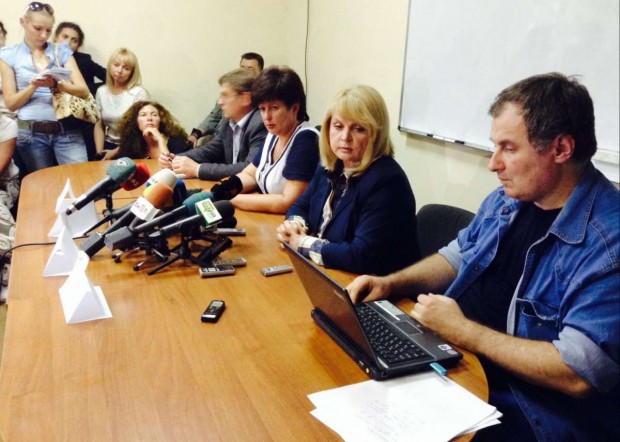
Aleksandr Cherkassov of Memorial Human Rights Center, foreground, with other Russian and Ukrainian human rights advocates at a meeting of the Ukrainian Human Rights Ombud Valeriya Lutkovskaya and Russian Human Rights Ombud Ella Pamfilova 13 June 2014 during a joint mission to Ukraine.
Yuri Dzhibladze, a long-time campaigner for human rights in Russia commented on his Facebook page:
“The government’s war with civil society has moved to a new phase. The Justice Ministry has included five leading non-governmental organizations in the list of ‘foreign agents’ […] Even though their court proceedings were not yet finished. Apparently now ‘the worse, the better.’
Such a practice (including the very use of the term ‘foreign agent’) was already tried in the Soviet era and did not lead to anything good.
The current regulations about ‘foreign agents’ passed on an emergency basis are aimed not at resolving real problems facing the country but only to weaken civil society of Russia.
We are left to reiterate what we have said in the last two years, from the moment the ‘foreign agents’ act was passed in the State Duma: this law shames Russia, it should not be improved or amended but should be abolished.”
Dzhibladze added that another organization, Coming Out, defending LGBT rights, was also entered into the registry by the Vasileostrovsky District Court in St. Petersburg.
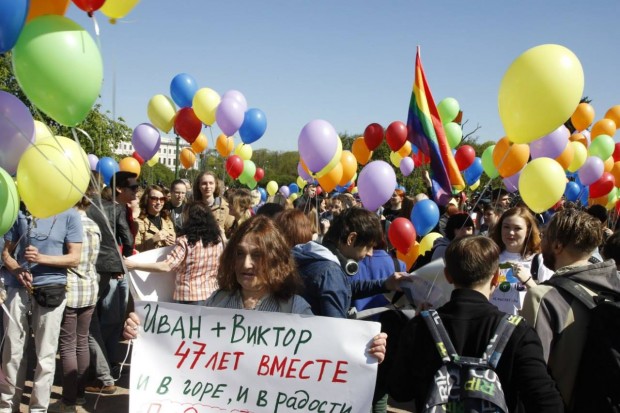
Gay flash mob staged by Coming Out in St. Petersburg. Sign says: “Ivan and Viktor, 47 Years Together, in Sorrow and Joy”.
July 21, 2014
1753GMT: The Russian Defense Ministry gave a briefing today for the press in which they claimed that information released by the Ukrainian government on Friday about Russian-backed separatists’ possession of the Buk anti-aircraft missile system likely used in the shoot-down of the Malaysian airliner was a hoax.
Defense ministry gave journos a copy of the slides they showed – also online here: http://t.co/N2q2jsko6u #MH17 pic.twitter.com/MePZ9QiYzZ
— Paul Gypteau (@paulgypteau) July 21, 2014
Among the items addressed at the briefing was a short video released by the Ukrainians showing what appears to be a Buk anti-aircraft system on a truck escaping for the Russian border. As we reported on our Ukraine Liveblog, the Buk was spotted before the shoot-down of the Malaysian airplane and ultimately geolocated to the town of Torez, near the location of the crash in Grabovo. Then the video, taken early the next morning on 18 July, showed a scene in Krasnodon, Interior Minister Arsen Avakov said in a Facebook post 18 July:
Since then, there has been a massive effort online to geolocate the billboard/Buk video. And soon enough, the Kremlin troll brigade came up with a counter-narrative which they injected into thousands of web site discussions, social media, news comments, and so on, as we reported this weekend.
They claimed that in fact the billboard/Buk scene was in Krasnoarmeysk, and the proof of that was the ad on the billboard, which is for the Bogdan auto dealer which has a showroom at No. 34 Dnepropetrovskaya St. in Krasnoarmeysk. To be sure, there is a Bogdan showroom in Krasnoarmeysk, but that address is in fact not visible on the billboard in the video; it’s covered by trees. The Russian Defense Ministry briefing interpolates this address in its notation to the screenshot of the video, but in fact it’s not visible at all in the video — it’s speculation. The Russian state media and legions of social media posters have also claimed that the vantage point of the videographer looked on to a shopping mall where there was a StroiDom store.
There were a number of things wrong with the claim that the scene was in Krasnoarmeysk:
1. Krasnoarmeysk has power lines but no trolleybus system; Krasnodon has a trolleybus system; the billboard/Buk video clearly shows trolleybus lines.
2. The Bogdan dealerships are all over Ukraine, and can be found also in Lugansk, 45 minutes’ drive from Krasnodon, where a billboard might be reasonably placed.
3. The StroiDom in Krasnoarmeysk is indeed listed at No. 49 Gorky Street, but the building doesn’t match the scene in the video. [Note: previously we erroneously noted the StroiDom on Lermontov St, but that’s the location in the Russian city of Krasnoarmeysk — it’s a chain of stores with multiple locations.]
Since then, Kremlin propagandists have furthered the claim by showing the location of No. 49 Gorky St. on Google maps, purporting to be a vantage point on to the shopping mall matching the camera perspective of the videographer who made the billboard/Buk video — red and white buildings seem to match.
Here’s a screenshot provided by @AricToler of the Google maps version of the site claimed by the Russian government. This is the location mentioned by the Russian Defense Ministry in their explanation starting at 10:18 on the video above:
This is the vantage point claimed by Russia for Bogdan BUK video. Judge for yourself. @Brown_Moses @catfitz pic.twitter.com/qBXcWa4Zbm
— Aric Toler (@AricToler) July 21, 2014
So our problem with that claim is as follows:
1. The videographer’s perspective in the billboard/Buk video is on an elevation, looking down on the buildings into the next street; Krasnoarmeysk has no such elevation.
2. The red rectangle in the billboard/Buk video appears to be a fence, with a white pole in it, not the red roof of the shopping mall as in Krasnoarmeysk. And the trees disappear behind this building in the billboard video.
3. The small, triangular building in the billboard/Buk video in the background, below the cameraman’s position is small with a sharply sloped roof like other homes in Krasnodon and appears to have a smoke stack; the Krasnoarmeysk shopping mall is two storys and has a flatter roof without a smoke stack.
4. The scene in the billboard/Buk video has trolleybus lines; Krasnoyarsk doesn’t have such a trolleybus system and the area shows power lines which look different.
Here’s a photo of the Krasnoarmeysk mall on Panoramio/Google maps.
In short, we don’t see anything at all to match the billboard/Buk video. The Russian government claim is that the Ukrainian government has perpetrated a hoax, and supposedly released footage of their own Buk in a location nowhere near the area of the shoot-down of the Malaysian plane, the town of Krasnoarmeysk in area controlled by Kiev. But in fact the Russian claims cannot be verified.
A user named evgenriv has happened to take a photo uploaded to Google maps which is right next to the scene at No. 49 Gorky Street in Krasnoarmeysk claimed by the Russian Defense Ministry to be identical to the scene in the billboard/Buk video.
Again, there are a number of things that in fact aren’t a match — 1) the area is flat, not on an elevation; 2) there are power lines, not trolleybus lines; 3) the painted telegraph poles aren’t quite the same at the base.
We’re continuing to look at this information, and also at a Panoramio photo taken by Evdokima taken a few meters south of the Gorky Street shopping mall that looks like in fact it does have a StroiDom store, which has a distinctive bright red/yellow/green sign. Directories can be outdated, or show offices, not all branches. But even so, this building is two storeys and doesn’t have a sloping roof like the much smaller building in the billboard/Buk video.
But at this point we don’t think the Russian Defense Ministry and the legion of Kremlin trolls who paved the wave for their briefing in thousands of social media sites have a match.
That leaves open the question of just where that photo of the Buk said to be rushed out of Ukraine to Russian by the separatists is in fact geolocated. Given that the shoot-down happened at 17:30 local time, it was already getting dark. If the separatists began driving the Buk away soon after they realized they had the wrong plane, they might get as far as Krasnodon or one of the other small towns in the Lugansk Region on the way to the Russian border, but time of departure and driving speeds, etc. are all uncertain and roads can be poor.
Keep looking.
Unless Russia produces more evidence than an unreadable line of "Krasnoarmeisk," no evidence says that BUK was there @Brown_Moses @catfitz
— Aric Toler (@AricToler) July 21, 2014
0925GMT: Ever since a video of the pro-Russian separatists anti-aircraft Buk system was uploaded to YouTube, legions of Russians and Ukrainians on social media have been trying to locate this scene.
As we reported on our Ukrainian LiveBlog, Ukrainian Interior Minister Arsen Avakov said on Facebook the Buk had been taken through Krasnodon and was headed to the Russian border. A Russian convoy had been spotted in Krasnodon on 15 July.
Given the short snippet of film, it seemed nearly impossible to find anything to confirm the scene, but when Hive Mind got to work, eventually people figured out that the billboard in the scene was from an autodealer named Bogdan, which had its showroom in Krasnoarmeysk, another town, and evidently no stores in Krasnodon but one in Lugansk. Then people speculated on the location of other buildings and painted telegraph poles and then debated whether the area could possibly be in Krasnoarmeysk at all, given that this town has no trolleybus lines (as clearly visible in the video), but Krasnodon does. Some maintained that the lines visible in the picture could be power lines, but trolleybus lines are unmistakeable as this old photo of Krasnodan’s trolleybus illustrates.
Still other social media commenters at Avva’s LifeJournal concluded that the short video was in fact taken when the Buk was still in Torez, where the Buk has been earlier confirmed as parked behind a gas station and some stores. User Alexey Bobkov bolstered his claim by producing a dash cam footage, much like the one used by Aric Toler to confirm the original parked Buk, only driving from the other direction, and said the curb, meridian and poles — and even the billboard — were visible near the clearly-identifiable StroiDom store with the yellow, red and green sign and the five-story striped-edged brown building with the video ad. The problem is that Torez doesn’t have trolleybus lines, either.
Meanwhile, it’s clear that Kremlin propagandists have now gotten into the geolocation game, seeing how much it has fascinated Westerners and been used by them to debunk Kremlin propaganda. On Friday and Saturday, we noticed as did Russian bloggers an identical post appeared on hundreds of sites — such as social media, news portals, news media comments sections, and blogs — claiming that the scene had been geolocated in Krasnoarmeysk — but that this proved that the Buks belong to the Ukrainian military, which had control of Krasnoarmeysk “since May 11” and therefore the Buk sighting video was Ukrainian disinformation. The post has the feeling of engineered propaganda not only because of its massive appearance everywhere simultaneously with either no name or various authors, but because it quickly appeared on Rossiya 24, Russian state TV, where Konstantin Knyrik coordinator of the South Eastern Front Information Center, a pro-separatist activist, repeated it almost word-for-word.
The Interpreter has translated the mass-produced post:
“A video is being disseminated in Ukrainian communities where supposedly the militia are hauling the shooting Buk toward the RF. But the city of Krasnoarmeysk is in the video, the billboard with the advertisement for the car dealership at 31 Dnepropetrovskaya St. Since 11 May and until now, the city has been under control of the junta’s forces, conducting the ATO! [anti-terrorist operation].
The Buk is missing one missile. In the photo and video with the trailer (the same one) there is a StroiDom [construction material] store. Address: Krasnoarmeysk, 49 Gorky Street. That is, the shooting Buk was located on a territory under the control of the junta and is still there. What questions are there? Everything is as clear as day — the Boeing was shot down by Ukrainian military by this very Buk, and now, in order for the video which leaked on to the web not to become compromising material, they decided to stupidly lay the blame on the militia, that they are hauling it. Remaining true to their lying nature (the Odessians burned themselves, the Luganskites blew up their own air conditioner, the DPR itself shells towns and so on). Mongrels.”
The propaganda technique here relies on a certain factology, playing on the fascination people have for geolocation. There are two things wrong with the story, however; one is that the StroiDom store isn’t at that location in Krasnoarmeysk, but on Lermontov St. The other is, of course, a lack of explanation for the trolleybus wires.
So it’s back to work looking through all the billboard companies in Krasnodon and their locations, and all the billboard companies in Krasnoarmeysk. Good luck!
